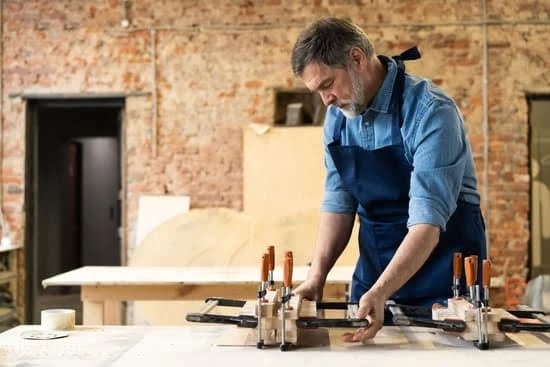Introduction to Miter Saw Woodworking
Miter saw woodworking is a great way to cut through wood quickly and accurately. Whether you are a professional or hobbyist woodworker, miter saws can be an incredibly useful tool for making intricate cuts in any material. In this article we will explore the basic benefits of using a miter saw, the types that are available, and some typical uses for them.
The main benefit of using a miter saw for woodworking is the accuracy with which it cuts. As compared with manual methods such as handsaws and chisels, miter saws can make angled cuts very precisely and repeatably. Being able to work with precision makes things like framing much easier, as pieces fit together better when exact measurements have been taken into account.
When it comes to types of miter saws available on the market, they generally fall into two broad categories: sliding compound mitersaws and static compound mitersaws. Sliding compound mitersaws feature an extendable arm pivoted at one end so that they can rotate back and forth up to an angle of 45 degrees left or right when cutting. Static compound mitersaws are similar but don’t have an extended arm so the blade remains in one spot and only swings up or down before making its cut. The latter type is often used for more intricate work where extreme precision is needed.
There are many uses for a miter saw beyond just cutting angles and mitering trim pieces around door frames. They are popularly used for picture framing, crown molding installation, window casing construction and other fine carpentry tasks where accuracy is paramount. Thanks to their versatility and repeatability they remain a hugely popular tool amongst professional carpenters worldwide!
Getting Started
Tools and materials needed:
When starting out with miter saw woodworking, it is important to have the right tools. These are some of the essential pieces that you will need to get started: a miter saw with a blade fitted, jigsaw blades and other attachments, a workbench or table to mount the miter saw, a measuring tape and marking tools such as squares, clamps for holding your work item in place during cutting, goggles for eye protection, dust masks for breathing protection from any flying debris or fine particles created during cutting, and ear defenders if you will be performing extended or loud cutting operations. You will also need wood specifically suited to your project such as lumber sections planed or cut into shapes according to what you envision.
Assembling the Miter Saw:
To assemble your miter saw correctly you should follow all provided instructions thoroughly. Make sure to use all appropriate tools for assembling your unit properly. Secure all necessary parts firmly when attaching them together ” do not rush this step as it can cause issues further down the line when operating your unit. If mounting onto a workbench you must make sure that everything is level and secure so that there is no risk of movement while using your saw. Finally remember to connect any power sources correctly before making cuts and turn off all safety locks before using the operation.
Safety Procedures:
It’s vital that before starting out any woodwork job with a miter saw that operators understand clearly how to safely operate their particular model without putting themselves or anyone at risk of injury. All users should be aware of potential hazards such as kickbacks or flying debris created by vigorous cutting motions. Therefore operators should always wear protective gear such as goggles, dust masks and ear defenders when working with power tools such as this one and should also perform regular maintenance on their machines in order to keep them running smoothly over time. You should always remain alert when operating these types of machinery; focus concentration at all times and follow recommended procedures for cutting planned items – including never ever attempting to force a cut through an item leaving skips behind in the process! Keep fingers away from moving teeth on blades or arms under any circumstances whilst machine is engaged Just check around area which has been cu too check no debris is left created by cuts made! Finally always read instruction manuals carefully prior to each use of any tool justa dn ensure they are aware of safety protocols well following manufacturers guidance ” ready eferign back when troubleshooting anything in future too
Proper Technique
When it comes to woodworking with a miter saw, there are several steps that should be taken in order to ensure accurate and precise cuts. The first step is to mark the material that one is working on. This can be done using a pencil, ruler, or other marking tool. It is important to ensure the correct measurements and angles are marked before beginning the cutting process.
The next step is to select an appropriate blade for the material being cut. Many factors, such as thickness and type of wood, will influence the selection of blade size and style. Once an appropriate blade has been chosen, then it is important to secure it in place within the miter saw guard.
The final step is making precise cuts on the material. This requires attention to detail and control over the saw’s speed and path. To maintain accuracy, it’s important not to rush through cuts or apply too much pressure while operating the miter saw handle. Steady movement while keeping an eye on measurements will help create precise results and reduce errors during cutting operations. Additionally, a good practice when cutting multiple pieces of material at once is entering each successive cut from a different angle in order reduce deviation from original line markings when finished cutting all crosscuts or miters.
Different Types of Miter Saw Cuts
Basic Cuts: Basic miter saw cuts are the most basic and simplest type of saw cuts. This kind of cut is used to make straight, 90-degree angle cuts through a workpiece. The workpiece is placed on a tabletop, the saw blade is adjusted to the desired depth, and then the saw motor is engaged and the workpiece is cut.
Angle Cuts: Angle cuts are more intricate than basic miter saw cuts. These types of cuts involve cutting material at an angle across its grain. To create this type of cut, you must adjust the miter saw blade to the desired degree of angle before making your cut.
Bevel Cuts: Bevel cuts are angled cross-sectional slices made with a power tool such as a miter saw or table saw. In this case, the bevel cut will be made with a miter saw. To achieve this specific angle you must adjust the blade from 0° up to 45° degrees in either direction”towards or away from you.. This can give your project a flawless finish when two pieces need to fit snugly together.
Compound Cuts: Compound miter saw cuts involves both being able to twist and tilt the corner points of intersecting boards within the same cut. Another description for it would be double compound which allows for more complex angles that require you to pivot not only in one direction but also have side-to-side movements involved in adjusting any one of those corners while keeping all other sections within their original location simultaneously – allowing you advanced precision cutting capabilities with a single bit machine.
Ripping: Ripping involves making straight lengthwise cuts along wood planks or plywood sheets (also known as ripcuts). This type of cutting is done so with specific tools that include table saws or circular blades like those found on chop and paneling/plank processing machines or even handheld ripsaws (usually reserved for thick lumber or rafts since they can easily tear apart weaker materials). With a traditional miter saw, you may only make few ripping style adjustments for long boards due to limited space compensation on most home models – but those should provide enough accuracy if needed around small DIY projects!
Creative Projects To Try
Miter saw woodworking is a great way to create custom projects at home. With the right tools and knowledge, you can make picture frames, chests, toys, furniture, and much more! If you’re just getting your feet wet with miter saws, start with a simple project such as a picture frame or desk. Make sure you measure your lumber accurately for accuracy when constructing your projects. Be sure to practice safety measures like wearing eye protection and double-checking programs to avoid accidents.
Once you get the hang of miter sawing basics, try incorporating decorative elements such as routing patterns into your projects. If you want to go even further and truly challenge yourself, there are many advanced miter saw techniques such as tapering legs for chairs or cutting intricate crown molding for cabinets. Explore some woodworking videos online or in books to find inspiration for all different kinds of projects that will showcase your unique woodworking skills. You’ll be amazed at what you can do with a miter saw!
Maintaining Your Miter Saw
Cleaning: Firstly, remove any dust and particles from the saw blade as well as the blade guard. If you have been using oil-based products, it might be a good idea to clean the throat plate, table saw, and other parts with a damp cloth. Inspect for any rust on the exposed surfaces of the miter saw before moving on to lubrication.
Oiling: Add oil (preferably light machine oil) along the length of the cutting blades as well as other moving parts inside the miter saw. Remove any build up of residues or excess oils on these surfaces. Make sure that each part is adequately covered in oil and then proceed to wiping everything down with a fine cloth once done.
Storing: When storing your miter saw away, make sure that all movable parts are secure and no dust or particles can enter into them while they are not in use. Store your saw uncovered in an area with plenty of circulation and away from direct sunlight; this will help prevent rust build-up over time.
Minor Repairs: Regularly inspect all bolts, screws, and washers for signs of wear or loosening; tighten them if needed. Also check for warping in wooden faces due to environmental changes like humidity fluctuation. To address such issues, look for minor repairs or replacing parts if necessary.
Ending Your Woodworking Journey
Miter saw woodworking is an essential skill for any woodworker looking to create professional-looking pieces. With its ability to make precise and accurate cuts, a miter saw allows you to create impressive angled joints and compound crosscuts. Learning how to use a miter saw is a critical step in the journey of any woodworker planning on taking projects from start to finish.
Once you’ve become familiar with using your miter saw, the next step is to ensure that it will provide reliable performance over long terms of use. Regular maintenance and cleaning will keep your saw running smoothly, but there are also specific steps you can take to maximize longevity. For instance, whenever changing a blade or making adjustments, you should always unplug your saw since it has important moving parts which can be damaged if instructions aren’t followed properly. Only using high quality blades is also key”cheaper blades tend to wear out more quickly or even break off during use!
Although preventive maintenance can help reduce the chances of technical issues arising while using your miter saw, it’s inevitable that some problems will arise eventually. A common issue with many miter saws stems from worn down teeth on their blades over time; this causes incomplete cuts due to slipping parts and uneven angles in each cut. With this in mind, it’s always important to check for dirty spots and dull edges on the blade’s surface before cutting through each piece of wood. If needed, consult professional guidance from consumer service forums or technical experts when dealing with mechanical troubleshooting issues related specifically to your type of miter saw model.
With the right techniques and knowledge under your belt, as well as proper maintenance of your tools and materials, any aspiring furniture maker or DIY enthusiast should be able to safely utilize their miter saw without difficulty. Maintaining safety protocols while working with such complex equipment ultimately contributes towards having enjoyable experiences while the most appreciated resulting outcome”beautiful pieces!

Hi everyone! I’m a woodworker and blogger, and this is my woodworking blog. In my blog, I share tips and tricks for woodworkers of all skill levels, as well as project ideas that you can try yourself.





